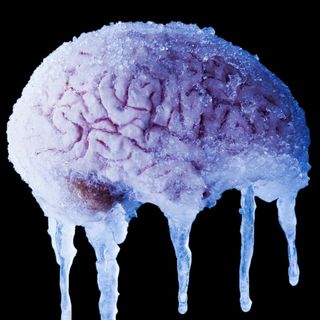
The Health Condition That Causes Unexpected, Unwanted Sexual Arousal
People who suffer from persistent genital arousal disorder may feel constantly on the verge of orgasm, but never actually climax.

“You’re never satisfied. I’m tired; I’m exhausted. But I know that in the next couple of seconds, minutes, hours, another one’s going to hit. But one day I decided to count how many orgasms I had. I counted 180 in two hours — everywhere I had to go. Pretty much with that type of number, you’re having 2 or 3 in a minute.”
This is Cara Anaya, as she recounts her experience with unwanted, unexpected sexual arousals. She suffers from persistent genital arousal disorder, or PGAD. Occurring mostly in women, it is a condition characterized by “unprovoked sexual arousal or orgasm of uncertain cause,” as described by Pain Reports, the official publication of the International Association for the Study of Pain. Eleanor Margolis, in an article for The Guardian, writes, “Those who have it often feel permanently on the verge of an orgasm that they can’t complete – a sort of chronic clitoral constipation.” Every person experiences it differently, she adds. Some feel aroused constantly but fail to reach an orgasm while others may have multiple orgasms, but they don’t feel satisfied.
PGAD doesn’t always match sex drive. The National Center for Biotechnology Information (NCBI) states that PGAD shouldn’t be confused with hypersexuality. The latter, the NCBI states in a study, “manifests as excessive desire with or without persistent genital arousal.” It adds, “The key difference between the two is that PGAD manifests as persistent genital arousal in the absence of desire. It is a very rare condition, and it is possible that the sufferers do not report the condition because of shame and embarrassment.”
Therefore, we dug deep to understand a condition we speak and know so little about.
What are the causes of PGAD?
PGAD is a neurological condition caused by lesions on the lower spinal cord, roots, and nerves that manage sexual response or a compressed pudendal nerve, which carries sensation around the genitalia, as stated in a recent study authored by Dr. Saurabh Sharma, of McLean Hospital and Harvard Medical School, and colleagues.
Healthline confirms that PGAD can occur alongside mental health issues such as depression, bipolar I disorder, and obsessive-compulsive disorder, but it’s unknown how the two are related.
Is it possible for men to have PGAD?
According to Dr. Sharma’s study, PGAD occurs mainly in women — but a few cases have been reported in men, too. PGAD is known as priapism in men — “a persistent and unrelenting penile erection without sexual desire,” Medical News Today (MNT) states. The male version of PGAD may develop due to complications from vasectomy procedures or urinary tract infections, it adds.
Related on The Swaddle:
The Importance of Orgasms, From Women Who Don’t Have Them
In women with PGAD, what can trigger arousal?
Dr. Sharma writes, “Arousals could be triggered by a wide range of factors, or by nothing at all,” while Margolis adds that anything from, “a bumpy train ride, to inserting a tampon, to wearing stilettos (which offset the balance of the pelvis) can exacerbate the extreme genital sensitivity.”
What are the symptoms of PGAD?
According to MNT, the symptom most experienced by women with PGAD are continuous sensations of arousal in and around the genitalia – the genital tissues, including the clitoris, labia, vagina, perineum, and anus – in the absence of any sexual desire. These sensations are known as dysesthesias and can include wetness, itching, pressure, burning, pounding, or the feeling of pins and needles.
PGAD patients may constantly feel they are about to experience an orgasm or may feel a series of spontaneous orgasms. These episodes of arousal can occur many times a day, and over weeks, months, or even years.
In men, symptoms may include pain in the penis or erections that last several hours. Other symptoms of PGAD in men include the face and neck becoming red, high blood pressure, muscle spasms, and blurred or spotty vision.
How is PGAD diagnosed?
PGAD was first documented in 2001 by Dr. Sandra Leiblum, a professor of clinical psychiatry at The University of Medicine and Dentistry’s Robert Wood Johnson Medical School. In her paper, she listed five criteria for an accurate diagnosis of PGAD. They include:
- “Involuntary genital and clitoral arousal that continues for an extended period of hours, days, or months;
- No cause for the persistent genital arousal can be identified;
- The genital arousal is not associated with feelings of sexual desire;
- The persistent sensations of genital arousal feel intrusive and unwanted;
- After one or more orgasms, the physical genital arousal does not go away.”
A physical examination of the genital area is also typical, as well as tests to measure the blood flow to the genitals before, during, and after sexual arousal, and neurological testing to see if any damage to the pudendal nerve is responsible for the condition.
Can PGAD be treated?
The NCBI states current plans focus on symptom management, which varies from case to case. While some may be prescribed therapy to manage any mental health issues that may be worsening their condition, in more extreme cases, electroconvulsive therapy may help ease symptoms, MNT states. Antidepressants and anti-seizure medications have also been found to be effective. There is, unfortunately, no treatment that leads to a full cure.
Anubhuti Matta is an associate editor with The Swaddle. When not at work, she's busy pursuing kathak, reading books on and by women in the Middle East or making dresses out of Indian prints.
Related


A Primer on Schizophrenia, the Psychiatric Disorder Affecting 20 Million People Worldwide
